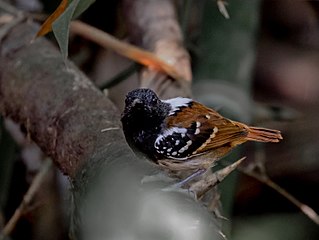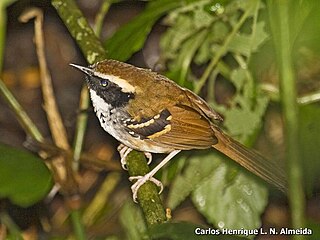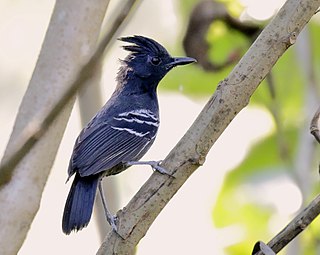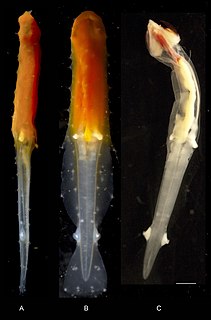
Chaetognatha is a phylum of predatory marine worms that are a major component of plankton worldwide. Commonly known as arrow worms, about 20% of the known Chaetognatha species are benthic, and can attach to algae and rocks. They are found in all marine waters, from surface tropical waters and shallow tide pools to the deep sea and polar regions. Most chaetognaths are transparent and are torpedo shaped, but some deep-sea species are orange. They range in size from 2 to 120 millimetres.

Cape Melville is a headland on the eastern coast of the Cape York Peninsula in Australia. To its west lies Princess Charlotte Bay. It is part of the Cape Melville National Park.

The stub-tailed antbird is a species of bird in the family Thamnophilidae. It is found in Colombia and Ecuador. Its natural habitat is subtropical or tropical moist lowland forests.

The ferruginous-backed antbird is a species of passerine bird in the family Thamnophilidae. It inhabits the Guyanas and the northern Amazon Basin. Its natural habitat is subtropical or tropical moist lowland forests.

Goeldi's antbird is a species of bird in the family Thamnophilidae. It is found in Bolivia, Brazil and Peru. Its natural habitat is subtropical or tropical moist lowland forests.

The southern chestnut-tailed antbird is a species of passerine bird in the family Thamnophilidae. It is found in the Amazon Rainforest in far southern Colombia, eastern Peru, northern Bolivia, and western and central Brazil.

The blue-lored antbird is a species of antbird in the family Thamnophilidae. It is found at low levels in humid Andean forests in western and northern Colombia, western Venezuela. It formerly included the Zeledon's antbird as a subspecies. The blue-lored antbird feeds on insects, and regularly follows swarms of army ants in order to catch prey flushed by the swarms, but it is not an obligate ant-follower like some species of antbirds. The blue-lored antbird is strongly sexually dichromatic: the male has an entirely black plumage, while the female has a rufous-brown plumage and a black mask. Both sexes have a blue patch of skin around the eyes.

The white-bibbed antbird is a species of passerine bird in the family Thamnophilidae. It is endemic to Brazil.

The white-shouldered antbird is a species of bird in the family Thamnophilidae. It is found in Brazil, Colombia, Ecuador, and Peru. Its natural habitat is subtropical or tropical swamps.

The Esmeraldas antbird is a species of bird in the family Thamnophilidae. It is found in Colombia and Ecuador. Its natural habitats are subtropical or tropical moist lowland forests and subtropical or tropical moist montane forests.
The scalloped antbird is a species of passerine bird in the family Thamnophilidae. It is endemic to Brazil.

The white-lined antbird is a species of bird in the family Thamnophilidae. It is found in Bolivia, Brazil, and Peru. Its natural habitats are subtropical or tropical moist lowland forests and heavily degraded former forest.

Marine invertebrates are the invertebrates that live in marine habitats. Invertebrate is a blanket term that includes all animals apart from the vertebrate members of the chordate phylum. Invertebrates lack a vertebral column, and some have evolved a shell or a hard exoskeleton. As on land and in the air, marine invertebrates have a large variety of body plans, and have been categorised into over 30 phyla. They make up most of the macroscopic life in the oceans.

Eumunida picta is a species of squat lobster found in the deep sea. The species is strongly associated with reefs of Lophelia pertusa, a deep-water coral, and with methane seeps. It is abundant in the western Atlantic Ocean, where it is found from Massachusetts to Colombia.

Heterokrohniidae is a family of sagittoideans in the order Phragmophora.

Archeterokrohnia is a genus of chaetognaths in the family Heterokrohniidae.The total body length excluding tail fin 28.5; the tail section is 55.2% of the tail fin; head blunt when hooded, triangular after preservation, head with 3.5 mm. Furthermore, the eyes are absent, the trunk section is orange throughout in life, and the organism exists around 3200 m below sea level.
Eukrohnia fowleri is a deep-sea marine arrow worm. It is the only known bioluminescent member of the genus Eukrohnia, and one of the two known species of bioluminescent arrow worms, the other being the distantly related Caecosagitta macrocephala. The bioluminescent organ of Eukrohnia Fowlery is found along the center of its tail fin on both its dorsal and ventral side. It has a secreted bioluminescence that is thought to be coelenterazine based. While both species use luciferases in conjunction with coelenterazine for light emission, the luciferase of Eukrohnia fowleri is highly stable after 30 minutes while the luciferase of Caecosagitta macrocephala becomes inactive. So far, there is no other bioluminescent organism that uses hexagonal packing in order to hold bioluminescent materials/ E. fowleri evolved through the adaptation to hypoxic water and due to the recent oxygenation of water they have been experiencing bottleneck events. These events have been seen as one of the reasons that E. fowleri have such low biodiversity.
Xenokrohnia is a genus of chaetognaths in the family Heterokrohniidae. It consists of one species, Xenokrohnia sorbei Casanova, 1993, which lives in a marine environment. The initial discovery was made from six specimens found in a deep-sea search in the Bay of Biscay for Spadella equidentata Casanova, 1987. A uniquely large (ventral) secretory gland, separate from other chaetognaths, defined the new genus and species. The gland, which is likely used to rid the body of digestive fluids, is probably due to the unique feeding habits of the species; these may include scavenging habits. The presence of an unusual and seemingly superfluous digestive utility is similar to Archeterokrohnia palpifera Casanova, 1986, which have a larger pair of pedipalps then what is common for chaetognaths.
Australaugeneria is a genus of marine annelids in the family Polynoidae. The genus includes 4 species which are commensal on octocorals.
Austropolaria is a genus of marine annelids in the family Polynoidae. The genus includes a single species, Austropolaria magnicirrata, which is known only from the Amundsen Sea in the Southern Ocean, at depths of 1000 to 1500m.













